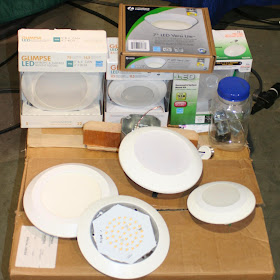I have proven the 4" Glimpse equivalence to a 100 watt incandescent in many unambiguous side-by-side comparisons, including this, my first:
100 watt incandesce
It is tragic when this Glimpse fully-revealed directional LED light is packaged as equal to a useless 45 watt bulb. Little wonder it is so poorly known, and not yet respected.
The 4" Glimpse diodes are tightly spaced on a simple board, slightly recessed within the lens frame. This four-year-old technology is now ancient, yet I know of no better light for its purpose. Know that it must be mounted on an air-tight box, else lens and mounting screw keys shine, attracting bugs. Despite defects, every lighting professional should experience this light. I recommend purchase at LED Lighting Wholesale . Look for then, and promote something better, in current technology.
Who will deliver a consumer luminaire with this better Samsung LED board of about 450 lumens?
http://www.samsung.com/global/business/led/lighting/led-engine/downlight-engine/detail/STIDMW830042112AAA
3000°K
4.2 watts
480 lumens
114 lumens per watt
62 x 5.7 mm (2.4" diameter, 0.22" thickness)
The diodes are distributed better than Glimpse, and will be less glaring for same lumens.
I do find the source. Buy the boards here:
http://components.arrow.com/
Who buys boards in this way, 180 minimum order? Please let it be someone who will package with least heat sink mass, a simple covering lens, push & pluck audio-jack connectors, and by-room DC wiring with in-wall conversion from house power. Can we move in this direction, away from stupid light bulbs, absent leadership for standards, as in a new L Prize?
This is my better L Prize vision:
I have proposed to US DOE that promoted LED lighting be as low-voltage DC-parallel strings of simple and small shining disks. We need a standard for a new common DC connector. This standard world-wide may be determined by competition as better expenditure in a next phase of the L Prize, than any new and stupid light bulb. All new light bulb installations stand in the way of adopting OLED when, soon, they are ready. The new L Prize for the connector sets a basis for the "starry skies" in our future. Luminares that clip into L Prize connectors might be called star lights. Such lighting will be dispersed and of small not-glaring size. Many of these little glow dots will be set in art pieces. They will be fun. They will be as nice or as simple as the user desires.
A proposal to US DOE? Never acknowledged. Some Booz Allen Hamilton contractor surely put it in the trash. Someone in Arlington answers if you call in follow-up. A real person, but without any options.
A proposal to US DOE? Never acknowledged. Some Booz Allen Hamilton contractor surely put it in the trash. Someone in Arlington answers if you call in follow-up. A real person, but without any options.
Here is an abbreviated savings comparison where luminaire density is that of an older home where 100 watt point source lighting was tolerated. New luminaires of brightness greater than B4 are down-rated in operating cost to that of B4 brightness, crediting dimming to B4, or value of the greater brightness to quality of life. Glimpse lights at 50 lumens per watt already wring out most of the potential savings. Further advances to >100 lumens per watt don't save much more in electricity cost, say another $15 over 35,000 hours, but do advance ability to live off-grid. Doesn't a more-efficient light run cooler? Advancing to >100 lumens per watt may be essential to small heat sink of a push/ pluck light.










